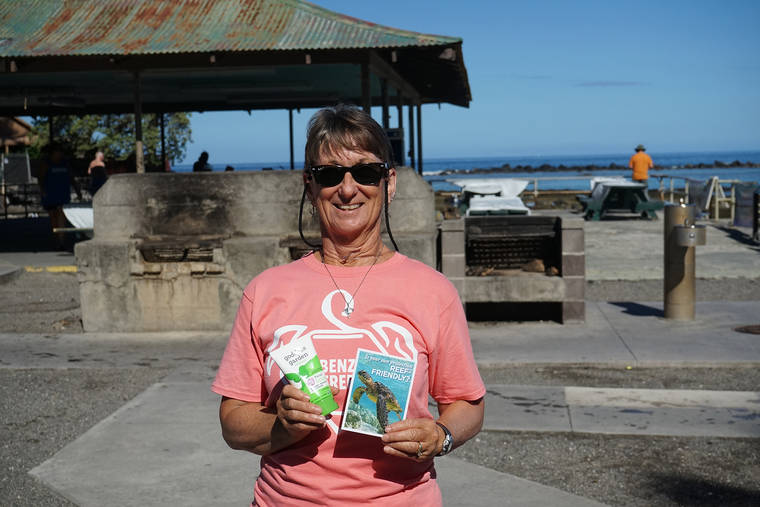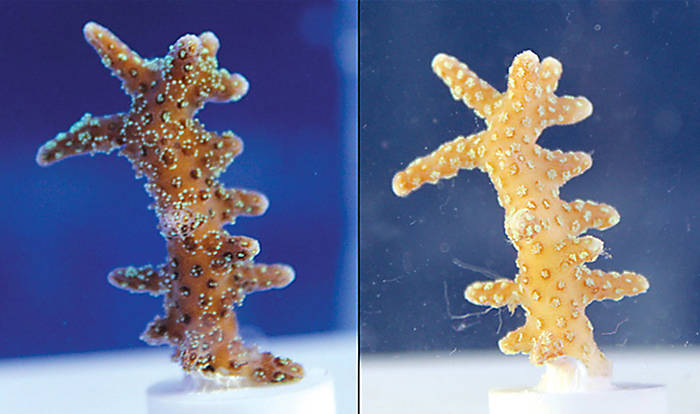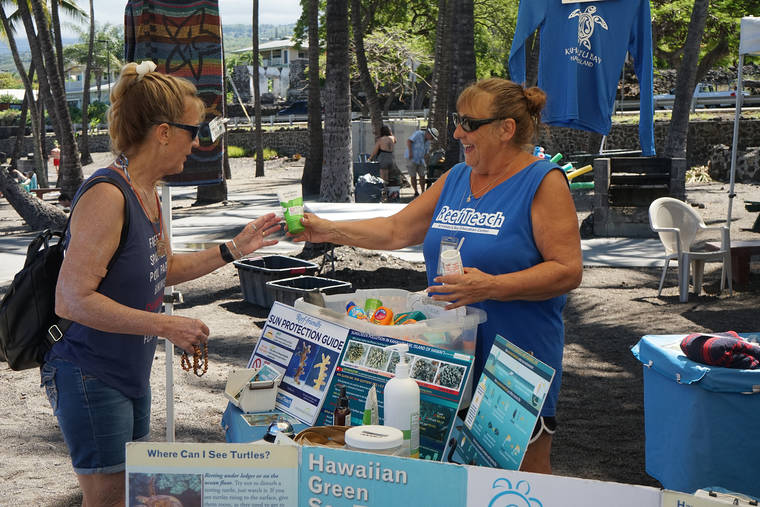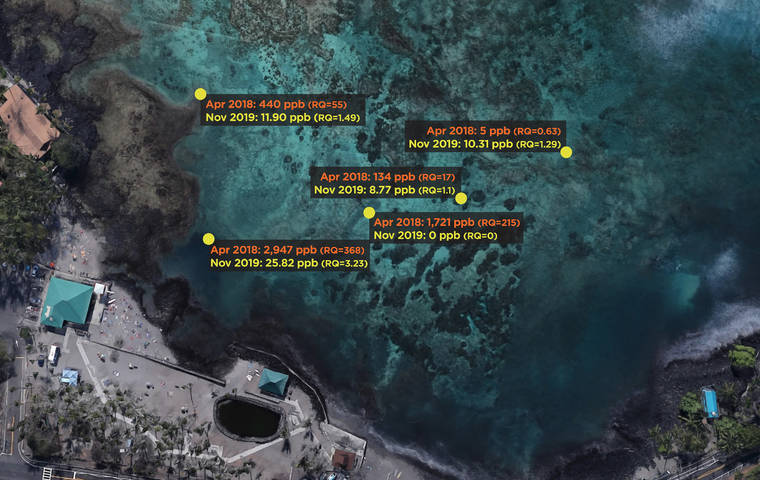Oxybenzone levels have dropped dramatically at Kahaluu Bay, The Kohala Center reported this week.
Between April 2018 and November, oxybenzone levels dropped 93% or more at water sampling sites in the bay amid the center’s ongoing “Reef-Friendly Sun Protection” campaign to educate bay visitors about ways to protect the Kahaluu’s delicate ecosystem, including wearing protective clothing and using mineral-based sunscreens.
“What these results show is that community stewardship works,” Punihaole said. “We are able to have meaningful conversations with hundreds of visitors every day to let them know about the damaging effects chemical sunscreens and physical contact with corals can have on our vulnerable reefs. We approach our guests as Aloha Ambassadors, asking for their help to care for Kahaluu’s marine ecosystem. A significant majority of our guests are unaware and want to do the right thing, they just need to be shown how.”
With Hawaii County beach parks reopened, Punihaole said Kahaluu Bay’s fragile ecosystem becomes vulnerable once again to damage resulting from swimmers and snorkelers stepping and standing on coral reefs, as well as diminished water quality due to sunscreen chemicals and other pollutants.
While Kahaluu Bay Education Center’s retail operations will remain closed indefinitely, program staff will be present on a daily basis beginning next week to provide on-site education about proper reef etiquette and the benefits of reef-friendly sun protection.
“We are putting out a plea to visitors to the bay to please extend social distancing practices to our corals and marine life, too,” said Kathleen Clark, marine stewardship and education specialist at The Kohala Center. “We urge swimmers and snorkelers to always use reef-friendly sun protection, and to keep a safe distance from marine life, corals, and even rocks that provide juvenile coral and limu (seaweed) a place to grow. If you must stand, please stand on sand. We all have a role to play in helping Kahaluu Bay heal and caring for all of Hawaii’s marine ecosystems so that they will continue to care for us.”
Oxybenzone levels declined from 93% to 100% at four of the five water sample collection sites. The northernmost sample site saw an increased presence of the chemical. Punihaole attributed the difference to visitors who do not access the bay from Kahaluu Beach Park not receiving on-site education through the campaign.
Laboratory tests confirm that oxybenzone, an active ingredient found in many common sunscreens, is contributing to coral decline. Oxybenzone and other chemicals affect coral growth and reproduction, and also harm fish and other marine life. While the effects of these chemicals on human health are not yet clear, studies have shown that these chemicals are absorbed through the skin into the body, prompting the U.S. Food and Drug Administration (FDA) last year to request safety data on 12 sunscreen active ingredients.
Currently, the FDA designates only two active ingredients as “generally recognized as safe and effective”: zinc oxide and titanium dioxide, which are naturally occurring compounds used in the mineral-based sunscreens the campaign recommends.
The campaign emphasizes that the most reef-friendly approach people can take to protect themselves from the sun is also the best for their own health: covering up. Clothing such as sunwear shirts and rash guards, hats, wraps, and board shorts reduce exposure to the sun’s ultraviolet rays while also keeping chemicals out of marine ecosystems. Small amounts of mineral-based sunscreens with non-nano zinc oxide or titanium dioxide listed as active ingredients are the next best option.
Since launching the campaign, the center has distributed more than 25,000 informational pamphlets and 10,500 samples of mineral-based sunscreens; swapped 144 containers of chemical sunscreen for full-size, mineral-based alternatives, and collected 436 pounds of chemical sunscreen for safe disposal.
While the substantial decrease of oxybenzone in the bay is cause to celebrate, Punihaole cautioned that the levels still exceed the U.S. Environmental Protection Agency’s risk quotient by as much as seven times at the sampling point closest to shore, where most swimmers and snorkelers enter and exit the water and many of the bay’s resident honu (green sea turtles) congregate to feed.
“The day we launched this campaign, the oxybenzone measurement nearest the shoreline was 736 times higher than the EPA risk quotient, so the fact it’s come down that much is huge,” she said. “But we’re determined to get the levels below what the EPA considers high risk, ideally down to zero. We have to continue our work. The bay is asking for our help. We need everyone’s kokua to save this cultural and ecological treasure.”
Dr. Craig Downs, executive director of Haereticus Environmental Laboratory, which facilitated the collection and analysis of both sets of water samples from Kahaluu Bay, agreed.
“Public education is an effective way of reducing actions that cause chemical pollution on our reefs,” Downs said. “Building relationships with more area businesses, particularly the retailers that sell or distribute sunscreens that threaten coral health, and encouraging them to switch to and promote reef-friendly alternatives instead would also have a major impact on water quality and ecosystem resilience.”
Sunscreens containing oxybenzone, avobenzone, octinoxate, octocrylene, and a host of other chemicals should be avoided. Starting on Jan. 1, 2021, Hawaii state law will prohibit the sale or distribution of sunscreens containing oxybenzone or octinoxate.
The ReefTeach program at Kahaluu Bay was started in 2000 by area residents who were concerned about the increasing volume of people visiting the bay and the impact it was having on the bay’s vibrant but fragile ecosystem. The Kohala Center assumed management of the program in 2008. In 2018, the program began to also focus on other stressors that impact water quality and ecosystem health, including pollutants such as sunscreen chemicals.















